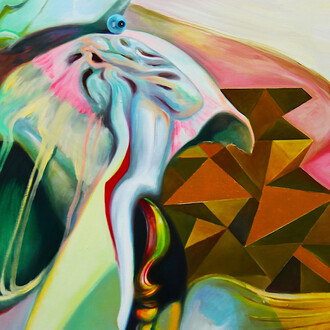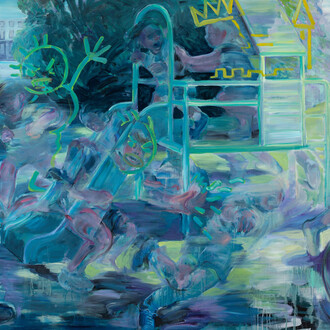Clearing is pleased to present L’autre rive, the debut solo exhibition in New York by French-American painter Coco Young.
The collective title of Young’s newest body of work translates literally to “the far side”—as in the opposite bank of a body of water—but can also be interpreted in relation to memory and the passage of time.
This proverbial “far side” can be inferred in the minutiae of Young’s art historical and autobiographical references, and is exemplified by the exhibition’s design: Five figurative vignettes dot the walls in the first of two exhibition spaces, followed by the immersive imposition of the Marécage polyptych in the back room.
In Jeune homme à la fenêtre (all works 2025), an unnamed man precariously props himself up over the low, wroughtiron balconette in Young’s Parisian studio, which is empty besides a few rolled-up and un-started canvases. Beyond staging a callback to the French Impressionist Gustave Caillebotte’s perspective-driven painting of workers scraping the floor of a bourgeois Hausmannian apartment on their hands and knees (Les raboteurs de parquet, 1875), Jeune homme à la fenêtre is an oblique memory of the period immediately following Young’s decision to take a leave of absence from New York in favor of Paris.
The first five paintings in this exhibition are defined in oblique relation to one another. De l’autre côté, for example, was painted from a composite of references including an iPhone photo of a window at the Rodin Museum, suggesting a portal or threshold bursting with daylight.
Mère et enfant, a tender depiction of one of the artist’s childhood friends reading to her infant daughter in the Tuileries Garden and the only other work featuring human subjects, initially suggests Young’s affinity for the American Impressionist painter of mothers and children, Mary Cassatt, but quickly goes off on a tangent of periwinkle petals and excited blades of grass.
Beyond her broad painterly vocabulary, the artist is intimately concerned with language and the capacity for language to be transformative or to be transformed itself. The title of Cygnes, for example, does not overstate the mythologyinducing image in question—a flock of black swans with crimson beaks contrasted against golden waters. On the other hand, the parenthetical voice of Untitled (poissons) reads as if mimicking Young’s spritely and evasive smudges of fish.
Marécage—as in, the monumental seven-panel series depicting adjoining views of a verdant shore—means marsh or bog. Without a marked beginning or end, the Marécage paintings, or “bog paintings,” are the anchors of L’autre rive.
Inspired by the artist’s affection for Pompeiian frescoes and her nostalgia for the Camargue wetlands on the French Mediterranean coast, each Marécage painting represents the satisfaction of Young’s desire (or “craving,” as she calls it) to capture the different diffusions of light during different seasons and times of day—from the fleshy humidity of Marécage (canicule), meaning “heatwave,” to the soft hush of dusk.
Amidst Young’s texture-forward application of oil on linen, the bog remains in layered stillness.













